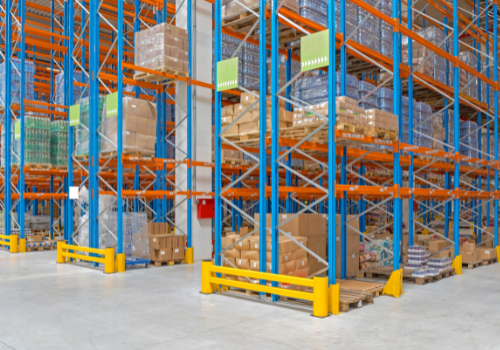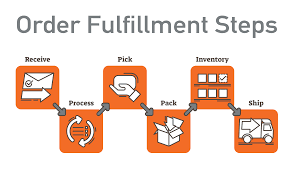There may be numerous critical winning factors for today's eCommerce retailers. But, in the end, they all point to the same thing: efficient, fast, and accurate order fulfillment execution.
In today’s eCommerce universe, even if you produce and sell the best product and market them well if you can’t get orders to consumers in a timely, cost-effective manner, you still lose their loyalty and repeat orders. According to statistics, almost 25 % of online shoppers cancel or abandon their orders because of unexpected slow delivery speeds. Not having a tested order fulfillment process can significantly impact a customer’s final purchasing decision, both now and in the future.
But exactly what is eCommerce order fulfillment, and how does it work? How can you make the process run more smoothly for your business to customer expectations? Learn more about Shoplazza’s fulfillment partners and process.

E-commerce Order Fulfillment Process
Order fulfillment is also referred to as inventory fulfillment or supply chain fulfillment. It is the process that is being executed between receiving a customer’s order and final shipping out the products to them.
The entire order fulfillment process includes many different parties, including merchant’s WMS systems, online store SaaS platforms, automated warehouses, fulfillment centers, and FBA. The process could look like this, processing orders, inventory data synchronization between warehouse and merchant’s system, shipment tracking data synchronization to merchants, item packing, and shipping products, for some of the fulfillment centers who even offer entire after services. An efficient and accurate fulfillment process enables businesses at any size and shape to deliver customers’ orders on time accurately.It is not just an order fulfillment, but a process of building customer trust and adhesiveness.
Why not take a look at the basic steps for the order fulfillment process. For most businesses, these steps may include and vary:
- Receive a newly placed order online, you receive a notification from the Shoplazza admin console.
- The system starts to synchronize the order information from your eCommerce operations platform (such as ERP software) to the fulfillment center or warehouse, where the Shoplazza system is open to any API integration.
- Next, the Shoplazza email notification system will notify the customer that you (as the merchant) have received the order. Meanwhile, Shoplazza email notification will take care of it automatically with its featured templates.
- Shoplazza's back-end system sends out a request for fulfillment through the API portal to your warehouse, fulfillment center or suppliers.
- The fulfillment center or warehouse receives the order and starts to pick the order from the warehouse.
- The fulfillment center or warehouse then packs the order according to the packing slip and shipping instructions, also shipping label
- Ship out the order to the customer. Customers are notified that their order has shipped when the Shoplazza email notification system kicks in again.
- Finally, the customer receives the order, and where the Shoplazza email notification system automates all the information and process.
- If any return or exchange requests take place, the Shoplazza after-sales module will kick in and process product exchanges and returns.
The above process applies to not just B2C orders (business-to-consumer), where products are sent to a single shopper’s home, and also B2B orders (business-to-business), where large quantities of products are shipped to retailers.
Why Is Accurate Order Fulfillment so Important?
Nearly 40% of online customers will not likely purchase from an online retailer again if they’ve experienced a poor shipping and delivery experience.
You may not be aware that it’s essential to spend much time perfecting your order fulfillment process, but it does play a crucial role in your success, directly impacting your bottom-funnel of sales. When 70% of online customers tell that on-time delivery directly influences customer trust.
Key Steps in the Order Fulfillment Process
Several moving pieces comprise the order fulfillment process, ranging from managing and routing new inventory to choosing the ideal packaging for the lowest practical dimensional weight.
Let’s take a deeper look at the complete process.
1. Receiving Inventory
When you purchase products from suppliers or manufacturers, you then receive that inventory at your fulfillment center or warehouse. At this stage, you’ll need to ensure accurate inventory counts, inspect products for damage, create product SKUs, and enter products into your inventory management system. With Shoplazza's featured built-in app, you can bulk create SKUs, it saves tons of precious time and energy, most importantly, it improves the accuracy of the SKUs.
2. Organizing Inventory
After the initial step, you’re now facing challenges in organizing it. Organizing products by category or SKU is a proven best practice that helps ensure faster order fulfillment.
This step is so crucial in brick-and-mortar stores. Employees and shoppers can quickly locate items that a customer is looking for if items are correctly labelled and organized. A customer is more likely to get frustrated and purchase a product elsewhere if you have unrelated items scattered across locations. For online stores, at Shoplazza, you can always create collections to categorize items and define the parameters and filters with your preference.
3. Locate order
After a customer places an order on your website, you now need to track it across existing inventories for order picking and packing. This is made easier with inventory and warehouse management software that functions as a central database repository for your merchandise.
Whether you, other team members, or warehouse robots are directed and responsible for picking the right products, the right software can facilitate fast and accurate inventory availability and order picking.
4. Order Packaging
Once the products for an order have been picked, it is time to pack the order appropriately to ensure safe and timely delivery. If you’re responsible for packing your own orders, you’ll need to develop a process for managing adequate supplies and packing materials such as boxes, cartons, bubble wrap, and more.
Always correctly pack fragile items so they don’t suffer damage before reaching your customer (TIP: safe, sustainable packaging is now seen as the gold standard and can lead to higher customer satisfaction rates).
If you pack yourself, you can always try ePacket.
5. Shipping out
After order picking and packaging, you must ship the order to your customer. Shipping methods may vary depending on whether you use third-party shipping services, merchant shipping, FBA, Canada Post or USPS, or simply dropshipping from a supplier.
Depending on your shipping options and shipping rates, you can list multiple shipping methods on your eCommerce platform. Your customers can pay for the shipping option of their choice. It’s very important to offer shipping options.
Some standard shipping options include:
- Free shipping: consider setting a minimum amount to make an order eligible for free shipping (this is a proven way to improve eCommerce sales)
- Table rates: calculate shipping rates using a table that considers factors such as destination, weight, cost, and a number of items.
- Flat rate: a fixed shipping price that is predefined for product delivery.
- Buy online, pick up in-store (BOPIS): if you have brick-and-mortar stores, let your customers choose to pick up their order at their closest store
If your eCommerce platform supports it, you may be able to offer your customers a choice of shipping careers (such as Canada Post, USPS, UPS, or FedEx) that will determine their fulfillment speed.
With Shoplazza, you can always refer to Shippo and EasyPost to look for your ideal shipping rates by printing the shipping label.
6. After-sales service
Product returns, exchanges and refunds are considered some of the most important parts of the order fulfillment process. The smoothness of refunding is decisive for if a customer would return to your store again! It is also a huge part of building up the sense of online shopping security. As a business owner, you should always consider successful order fulfillment beyond face-to-face delivery and endeavour to achieve smooth, transparent and fast aftersales.
As soon as a customer submits a refund or exchange, the after-sales order processing will kick in and be executed by the system. In the Shoplazza admin console, look for the aftersales to review all order details at once, which gives you the ability to generate product returns and exchanges quickly.
Here is a post-pandemic proven great practice, always include a “Return Shipping Label” for your customer. It offers a great customer experience, and it shows that the merchant is authentic, honest, and open to returning the products. It helps build a long term rapport with consumers.
Fulfillment Challenges
We’ve discussed that inefficient online order fulfillment problems are one of the most common root causes of losing customers, especially for eCommerce merchants with massive product catalogues or collections. Next, let’s take a quick dive into some of the most common challenges faced by all eCommerce business owners.
When a customer completes the order placing process, the product waiting period then immediately begins, and their anticipation builds along with the anxiety. It is the uncertainty that kicks in. When they receive an incorrect or damaged item, you don’t have to imagine how disappointed they may be.
Check for any damaged or defective items before shipping out any product (a scratch, a crack) and your customers always notice! Trust me!
Too much or not enough inventory
Any more ideas to kick your customers out of your door? When an item is sold, but you don’t even have the inventory.
Without inventory management or inventory synchronization software between your offline stock and online sales, It is risky to over-sell your products and ruins your reputation, leading to issued refunds and disappointed customers. Adopt proven practices to keep track of every product you own, then sync inventory levels between your online sales channels and fulfillment locations.
If there is a chance a product is out of stock or on backorder, clearly notify your customers in the product listing.
No Shipping Notifications
You may not be aware, once an order is placed, how anxious they could be just to wait for an email notification telling them that we received your order. Because, simply speaking, after the payment is completed, you and your customer automatically signed a binding agreement. The pressure, anxiety and expectations mount from now on.
A shipping notification that informs different parties where and when to expect their order to arrive. Online shopping is spiking, customers are long term trained to expect email or SMS notifications as soon as they complete the payment process. Many customers check their shipping status multiple times during a day before a clear delivery date can be displayed.
A shipping notification that informs different parties where and when to expect their order to arrive. Online shopping is spiking, customers are long term trained to expect email or SMS notifications as soon as they complete the payment process. Many customers check their shipping status multiple times during a day before a clear delivery date can be displayed.
In any case, if shipping notification isn’t issued and delivered to your customers promptly, you can be expected to receive complaints and bad reviews. You may also be directly linked to the online shopping scam. Check out our blog of Eye for online scams coming soon.
After Service Issues
What is customer service? It comprises multiple facets, including how you respond to your customers’ online questions via chatbots, emails or social media. But answering your customer is one of the most impactful facts that may directly contribute to your conversion rates. Once something goes wrong, they will expect answers and look for solutions. If your customer service can’t answer their questions in a timely and satisfactory manner to raise customer satisfaction levels, you might as well light your money on fire.
Shipping Speeds
Today’s customers expect to receive their orders as quickly as possible, with many eCommerce retailers offering two-day or next-day shipping to compete, especially if you are facing fulfillment giants like Amazon's same-day or next-day speedy service. If your entire order fulfillment process is complicated, it’s impossible to meet customer demands for rapid shipment speed. You also risk losing a future sale—they’ll purchase what they want from your competitors instead.
Ecommerce is a fast-evolving business, which means your fulfillment services need to be able to keep up. So, work with a fulfillment partner that can speed up your shipping timelines and satisfy your customers’ high expectations.
After-sales services
In the year 2021, eCommerce met a new high peek, also return delivery costs in the United States were estimated to be 600 billion dollars—and this figure doesn’t include expenses related to restocking or inventory losses! Most of this inventory will return to your distribution centers or warehouses if you don’t have a brick-and-mortar store. Customers value a return/exchange process that is quick and free. However, don’t promise a return policy that your partners aren’t prepared to carry out. This will negatively affect your customers’ experience and hurt your profit margins. It’s vital to choose an eCommerce fulfillment partner that has the proper procedures, infrastructure, and staffing in place to handle a high volume of returns and exchanges.
Different Types of Order Fulfillment
There are several types of online order fulfillment, but the most popular methods include merchant fulfillment, third-party fulfillment, and dropshipping.
Merchant Fulfillment
Merchant fulfillment is often called in-house order fulfillment and refers to handling order fulfillment “in-house” — without third-party involvement. You may choose to fulfill in-house if:
- Your business is still new, and your order volume is low
- You don’t have the budget to party with a third-party logistics company
- You complete order fulfillment from home
- Your eCommerce platform has built-in inventory management software that helps you achieve efficient order fulfillment on your own
Third-Party Fulfillment
If you outsource your order fulfillment process, you embrace third-party fulfillment methods. Third-party fulfillment partners manage all aspects of the process, from receiving inventory to shipping orders. One typical example of third-party fulfillment is “fulfillment by Amazon” (FBA). FBA encourages eCommerce retailers to partner with Amazon by sending products to Amazon for storage and fulfillment.
You may choose to go with a third-party fulfillment solution if:
- Your typical order fulfillment methods are too expensive
- You’re having issues managing the logistics of fulfillment
- Your business is small-scale
- Your order fulfillment process is slow and is leading to a negative delivery experience
- You want to scale your business quickly
Dropshipping
Another popular order fulfillment method is dropshipping. When you receive an order from a customer, you forward the order to your supplier, who then handles the logistics of picking, packing, and shipping. Dropshipping is a favoured method because it effectively balances order fulfillment between suppliers and retailers.
You may prefer dropshipping as a fulfillment option if you are new to eCommerce and have a minimal budget for fulfillment services. However, if you’re in a niche where speed of delivery is a priority, dropshipping is not a recommended option. Although it is convenient, it doesn’t provide much control over the supply chain. When you rely on a supplier or manufacturer to fulfill orders, you can’t help your customers track or receive their orders faster. Sometimes suppliers are located far from a customer, which can affect the speed of the order fulfillment cycle.
With Shoplazza's featured dropshipping partners, like CJDropshipping, HyperSKU, EPRolo, and many more, you can easily start dropshipping and print on demand (POD) anywhere anytime, only from $28/mo.
Choose Shoplazza as your SaaS online store building platform
Your eCommerce platform will be a significant factor in deciding the type of order fulfillment to choose for your business. You may choose to stick to merchant fulfillment if your platform supports inventory management and other tools that support order fulfillment. For example, some eCommerce platforms provide functionality such as tracking inventory across locations, the ability to add company warehouse locations as your business scales, real-time data, and more.
As a winning factor, Shoplazza dedicates to serving more than 360,000 merchants around the world. With open to more concepts, our global partner size keeps growing. At Shoplazza, you're not just picking up a featured online store builder, but also a diversity of tools and resources that you will need to construct a multiple sphered eCommerce empire, even if you are just yourself for the moment. With an award-winning admin console, orders, notifications, and after-sales, payments are automated with precision.
After all, our tip is to look into the options offered by Shoplazza AppStore and our partners. Make sure you have fully communicated to your shipping partners and know the details from the shipping vendors.
Sign up to Shoplazza today to get a 15% discount! Transfer your dreams into action today!
Stay tuned to Shoplazza Go Live Podcast across platforms.
- RSS.com
- Spotify
- Amazon Music
- Google Podcast
- Apple Podcast (coming soon)
- Samsung Music
Watch Shoplazza Women Entrepreneur Interview with our last guest Yorly Balu on Shoplazza Go Live Youtube channel.




